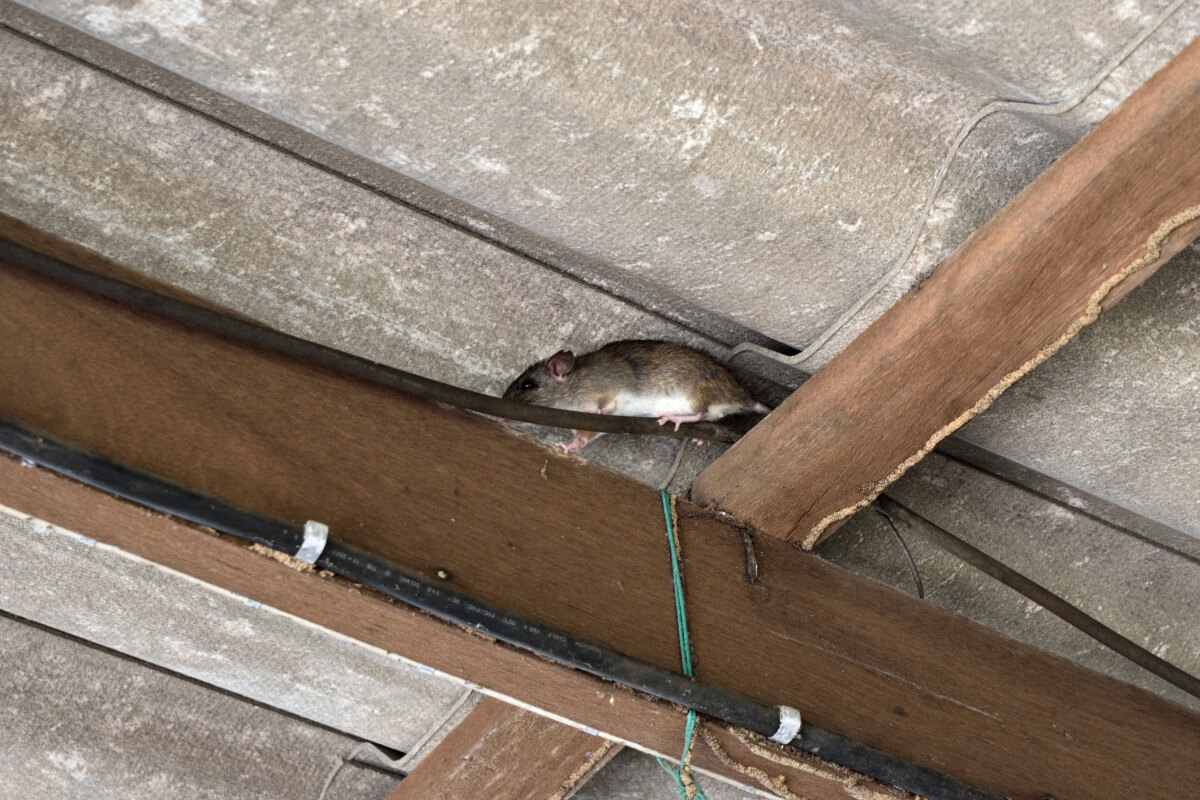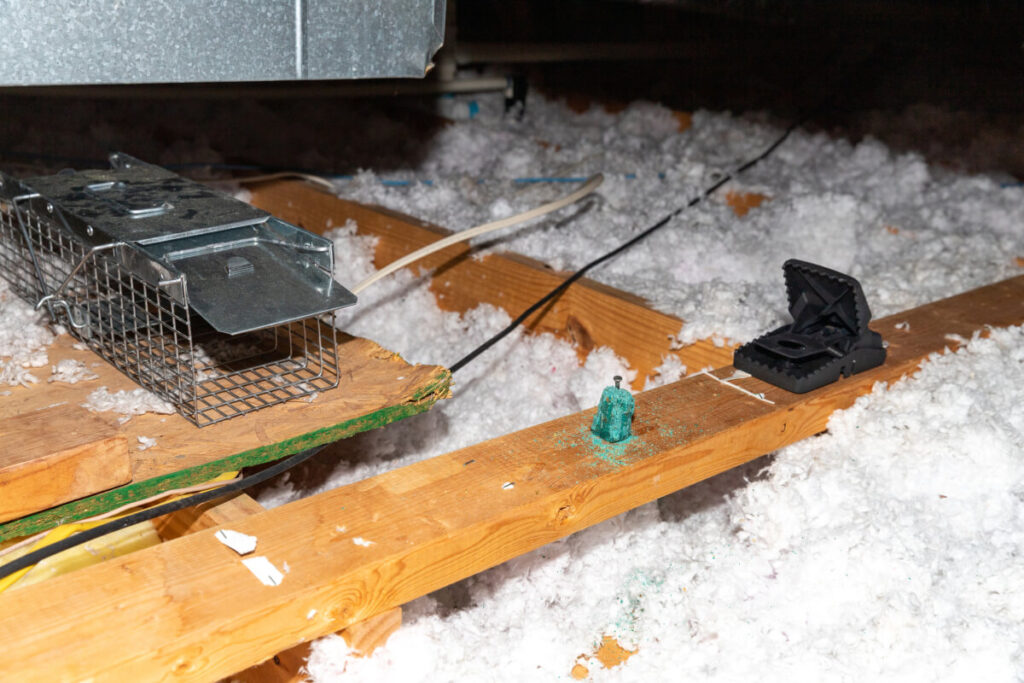
There are many types of rodents that can plague your home, and roof rats are one of them. On top of causing up to thousands of dollars in damages (especially to areas like your attic), rodents can carry diseases that can harm you and your household. And in coastal states like Connecticut, roof rats are a common pest that can invade homes in ways you might not even be aware of, even if you have set up traps for them.
So why aren’t your rodent roof traps working? Some common mistakes when trapping roof rats include using the wrong bait, setting the trap too fast, not looking for hiding areas or entry holes, and making your attic conducive for pests to breed, eat, and thrive.
Like other rodents, roof rats can be smart about how they survive in your home. Not only does this mean that you have to use your rat traps correctly, but you have to be smart about how you manage your DIY pest control. Here are some common pest control mistakes you might be making.
Unless you’re using traps scented to attract rats, you’ll need to make sure you’re baiting your traps correctly. First, make sure you’re using the right bait. Unlike other rats that eat meat scraps and a variety of foods rich in protein and carbohydrates, roof rats have a diet similar to squirrels. The following food can be used as bait:
Aside from food in rodent traps, roof rats may also look for nesting materials like string, cotton, and dental floss also makes good bait.
Second, you should only put a small amount of bait. If you notice that the food in your trap is always getting taken but the trap never sets off, it may be because you put too much bait. When you put too much bait, a rat may take or eat just enough to sate them without eating the whole thing. Rats have a good sense of smell, so a pea-sized amount of bait is more than enough to attract them. You want just enough bait that they have to eat everything.
Rats are intelligent animals, so they may be wary of new food sources popping up in their area. As a result, they may not be quick to fall for your traps. A good solution to this is to acclimate them to the trap before setting the trap.
For a couple of days, put bait in the trap but don’t activate the mechanism. This will lead rats to believe that the trap is safe. If you notice that the bait is disappearing, it can mean that the roof rats now use your trap as a safe food source. Once you can confirm this, add bait and set the trap.
Roof rats tend to be good climbers and nest in high points like your attic. One of the reasons why your traps aren’t working is because you’re not putting it close to areas where they’re likely to be hiding or their entry point into your home. So even if you do have traps set up, they’re not going to go anywhere near the area where it’s set.
Roof rats are agile climbers and can use tall objects like trees, vines, power lines to climb onto your roof to find an opening. They can even climb on rough flat surfaces like bricks and concrete blocks. Rat burrows the size of a nickel can let rats easily enter your attic.
Looking for their hiding areas can allow you to place your traps more strategically. If you’re not sure which area of the attic to start, look for signs such as rat droppings, active rat burrows with signs of nesting, and greasy rub marks. Try putting disabled rat traps with bait around the perimeter of the attic, particularly in dark and covered areas. As for entry points, check for rat holes or gaps in the walls or ceiling.
Let’s say that you’ve managed to trap a roof rat, only to find another one later on. This can mean one of two things: either you have an infestation of rats (which would need the help of a professional pest management company) or your home still has entry points that allow more rats to enter.
Preventive measures are just as important as installing traps to remove existing rats in your home. Taking steps to address possible entry points can prevent more roof rats from coming and needing you to take more steps to avoid an infestation. Keep reading to learn more about preventive measures later in this article.
Roof rats enter your home to escape outdoor predators and to hunt for food. They also look for areas that have access to food and water. So, if your attic is filled with potential hiding spots and they can find access to food and water around your home, they’re likely to make it their home and breed, which can increase your rat population into an infestation.
All attics tend to be dark and cluttered, but you can prevent your attic from looking like a good nesting place by removing food and water. Steps like sealing your food pantry properly and checking your plumbing for leaks can prevent your attic (and the rest of your home) from turning into an ideal place for pests to survive in.

Once you’ve fixed your common mistakes, you stand a better chance of trapping roof rats and preventing them from inhabiting your home. Some ways to trap roof rats successfully are to pick the appropriate kind of trap, acclimate the rat to their traps, using bait that roof rats will end up liking, and refraining from using rat poison.
There are a number of rodent traps you can use to manage roof rats, mice, and other types of rodents. It’s best to first identify what type of pest you’re dealing with, as the wrong type of trap can be ineffective. Using rat traps for mice may be too big, while using mouse traps for rats can be too small (and at the same time only inhumanely injure rats instead of a swift kill).
After you choose the right trap (such as a snap trap, electronic trap, glue traps, etc.), install the bait correctly. For bait traps like the snap trap, rodent bait has to be carefully placed on the trigger, while glue traps require bait close to it though not necessarily on the glue board. Place it along the perimeter of your attic, particularly near areas where the roof rats frequent.
Rats and mice can be wary about new food sources that appear in their area, which can make them careful around baited rat traps. A good way to acclimate rats is to leave the trap baited but unset for a few days. This can help you determine the general area they’re in as well as acclimate them to a new food source. Once you see the food disappearing every day, bait and set the trap, place it in its regular area, and wait for the trap to catch the rat.
Unlike other rat species, roof rats have a similar omnivorous diet as squirrels. While they’ll eat any food source if they’re hungry, their food preferences include:
Your best option is to use nuts or seeds, though peanut butter is a popular choice. Unlike solid food items that can be taken from a trap, peanut butter is sticky and can’t be picked up. This will require rats to eat it from the trigger, which can make it easier to activate and trap the rat.
You might be tempted to use rat poison, but this can cause problems if you don’t know their hiding place or where their rat holes are. After a rat eats food laced with rat poison, it will go back to its hiding place and die. Afterwards, the dead rodent can cause a foul smell in the house. Even if you locate the dead rodent and dispose of it, the scent can still linger for a long time.

Trapping roof rats can take time and plenty of effort. However, removing any existing rats and mice in your home doesn’t guarantee that there won’t be any rodents in the future that will make their way into your home. On top of your rat traps, you should also practice some of these preventive measures to prevent future possible infestations.
Proper sanitation keeps your home free of food and nesting material that attract roof rats. A cluttered and dirty home can also attract rats because of the many areas that allow them to move around. Some of the simple ways to keep your home clean include:
On top of keeping rats away from your garbage, it also helps prevent insects like flies and mosquitoes. Roof rats have an omnivorous diet and feed on small insects, so keeping your home clean can prevent attracting pests that rats can feed on.
Roof rats survive by going through your food and trying to get any sources of food that you’ve left unattended. Rodents have excellent senses when it comes to smell, and if food smells come from your home, they’re likely to go to it to search for food. By sealing your food items properly, you can prevent rats from finding your home sustainable for their survival.
Roof rats are excellent climbers and can get into your home through power lines, vines, trees, and even rough walls they can climb on that give them easy access to your roof. On your roof, if there’s no existing hole or gap to enter your attic (they only need a tiny hole the size of a nickel to get in), then they can chew a hole in the soffit and eaves section of your roof to enter.
If you leave these holes uncovered or unrepaired, then there’s nothing to stop any other roof rats in your area from climbing and entering through the same entry point. Look for potential entry points and then cover them up.
Some pet owners tend to leave food out for their pet throughout the day. If you want to avoid rats, it’s best to only feed your pet at specific times and make sure that they finish all the food in their bowl. Leaving their pet bowl of food at night can be rats’ source of food.
Make sure to also seal your pet’s food in an airtight container to prevent rodents from getting into it. If you have a habit of feeding your pet food scraps, make sure they eat the food instead of leaving it somewhere on the floor.
Aside from food, roof rats need a water source to survive. A leak in your plumbing system can be enough to sustain rats, so keeping your plumbing system fixed can prevent your home from being a conducive place for pests to breed and survive. Leaky water fixtures not only sustain pests but also damage your home, so it’s best to have these leakages fixed as soon as possible.
If you have a rat infestation, DIY pest management and rat traps aren’t enough to remove all your existing rodents. Rodent populations can grow quickly, so spot signs like rats moving in the daytime, mouse droppings, and getting into your food pantry. In these cases, it’s best to have a professional pest control team take care of removing all the rats as well as taking preventive measures on your home.
All rodents can potentially damage your property and give you and your loved ones unwanted diseases. The good news is this is almost always preventable. Correcting common pest control mistakes can help you catch rats better and take the necessary steps to prevent more rats from getting into your home. But when it comes to roof rats, it can be a bit tricky to catch with just DIY pest management.
In cases of pest and insect infestations, it’s best to leave it to the professionals. At Yale Pest Control, we don’t only eliminate pests in your area, as we also follow a careful and thorough protocol to keep pests away from your home for good. Contact us today for a free quote.
Learn More: How Do Rats and Mice Detect Spring Traps?